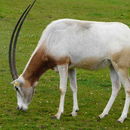Biology
provided by Arkive
This species is well adapted for survival in the dry areas it inhabits; it is able to live for nine to ten months without drinking, thanks to a number of specialisations including kidneys that minimise urine production and an ability to reach body temperatures of 46.5°C before beginning to perspire (9). In the wild, the scimitar-horned oryx lived in groups of up to 40, with much larger herds forming at certain times of year (9) (10). In the wet season these herds migrated to the north, returning at the onset of the dry season (9). Births occur mainly in March and October (2), and the female will separate herself from the herd for a few hours while she calves (6). The young become fully independent at around 14 weeks of age (6).
Browsing in the relative cool of the early morning and evening (6), these oryx feed on a wide range of grass species, foliage and fruit (9) (10).
Conservation
provided by Arkive
The species has successfully been bred in captivity and in 1985, five captive-bred pairs were reintroduced to Tunisia, and by 1989 the herd had produced 4 wild-born calves (9). Captive-bred oryx now exist in healthy numbers in both Tunisia and Morocco, and have been reintroduced into Senegal (1) (11). Individuals have also been introduced to Israel, although this was not within the historic range (9). Recent reports of sightings of oryx in Chad and Niger have been investigated but no animals found (1).
Description
provided by Arkive
The scimitar-horned oryx, so named for its magnificent curved horns, is now thought to be Extinct in the Wild, hunted to the brink of extinction for its meat and exceptionally robust hide (4). The stocky body is a pale colour, with brown markings on the face and a reddish-brown neck and chest area (5). The large, spread hooves allow these antelope to walk on the sand of their dry habitat (6).
Habitat
provided by Arkive
Inhabits sub-desert areas, the area between true desert and the Sahel where the annual rainfall is less than 350 millimetres, and lives in dunes, wooded depressions between dunes and grassy steppe (9) (10).
Range
provided by Arkive
The scimitar-horned oryx was once one of the most common large mammals of northern Africa with a range extending from Morocco and Tunisia to Egypt, reaching south to Mauritania and Sudan (7) (8). The range rapidly declined throughout the 20th Century, until in 1980 it was known only from Chad and Niger with a few individuals in Mali and Sudan. The species is believed to have become Extinct in the Wild in 1999 (9).
Status
provided by Arkive
Classified as Extinct in the Wild (EW) on the IUCN Red List 2007 (1). Listed on Appendix I of CITES and Appendices I and II of The Convention on Migratory Species (CMS or Bonn Convention) (3).
Threats
provided by Arkive
Originally the scimitar-horned oryx began to decline as a result of major climatic changes that caused the Sahara region to become dry. As the Sahara desert expanded, two populations of this oryx became increasingly isolated. The northern population was mostly lost prior to the 20th Century (8) (9). The decline of the southern population accelerated as Europeans began to settle the area and hunting for meat, hides and horn-trophies increased. It is thought that World War Two and the Civil War in Chad during the 1980s impacted heavily on the species through an increase in hunting for food (4) (9).

